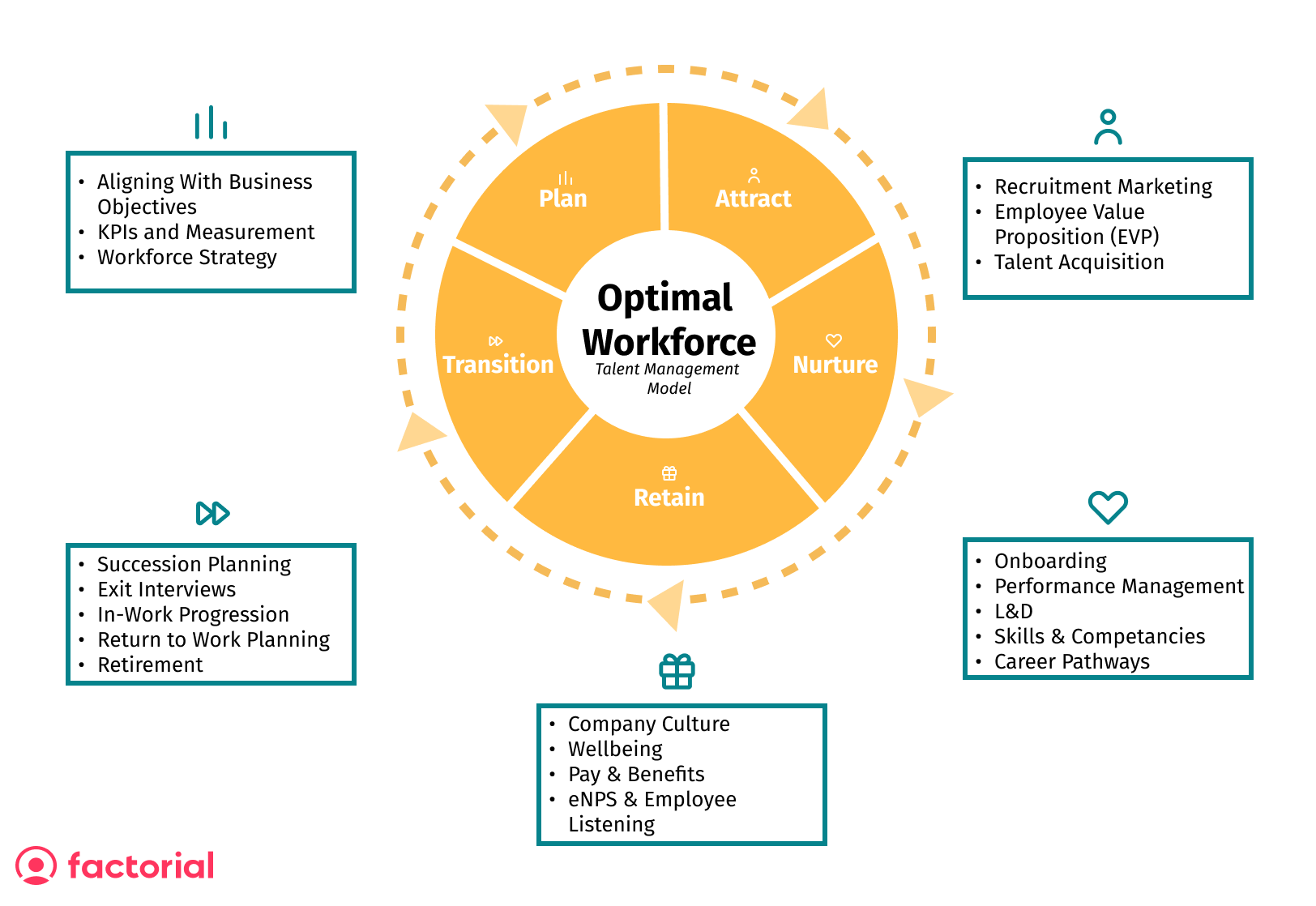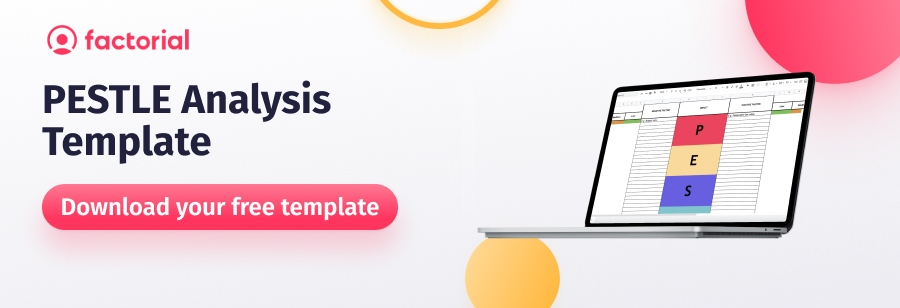What is Talent Management?
Talent management encompasses how a company recruits, develops and retains talent. It encapsulates every stage of the employee lifecycle and the strategy relating to each part. The ultimate aim is to attract top talent and nurture that talent to grow within your company. When done well, it can lead to higher employee satisfaction, lower turnover, and better business outcomes.
Your people are your company’s most valuable asset, which is why talent management is crucial to HR’s role. It is the responsibility of the People Team to oversee each part of the employment experience for an employee, all the way through, from the recruitment pipeline to the onboarding process, creation of company culture, internal development, and workforce strategy.
Company leaders can split the talent management cycle into five overarching sections:
- Plan
- Attract
- Nurture
- Retain
- Transition

In this article, we’ll cover each element of the talent management system.
Talent Management Strategy
An effective talent management strategy is built on six pillars. You’ll need to consider each one to ensure the base of your employee lifecycle is strong!
1. Cohesion with Business Strategy
There’s no ‘one size fits all’ approach to talent management strategy. You should tailor your plan to the needs of your business, so start by assessing talent gaps and pain points. Ask yourself: which skill sets do we need to achieve our company’s objectives and targets? Which values align with our company’s mission and ethos? How can we use the strengths of existing talent to push forward our OKRs as much as possible? However, be mindful of changing objectives and adjust to realign your strategy whenever the business changes theirs.
2. Consistency
Consistency is vital in ensuring everyone within your organisation is treated fairly. Ensure you have robust processes and policies in place that are easily accessible. Whether it be your remuneration strategy or reasonable adjustments, your talent should feel they’re on an even playing field.
3. Career Advancement
A whopping 94% of employees say they would stay at a company for a more extended period if they invested in their training employees and fostered a learning culture. A number this high is hard to ignore and proves that nurturing existing talent is crucial to talent management. Career growth programmes and future leader planning fall into this category.
4. Culture
Having a solid ethos and identity as a company isn’t enough. It’s about how you present these values through employer branding and hiring candidates that align with them. When it comes to new hires, think about culture ‘add’ instead of culture ‘fit’ to foster diversity in your workforce. These values should also shape the L&D programmes you offer.
5. Recruitment Marketing and Employer Branding
Attracting talent stems from this. Think about selling your company in the same way you would a product. Identify your USP – this is the seed from which your recruitment strategy should grow! It’s a surefire way to stand out from the crowd and elevate your talent strategy.
6. Adapt to Global Requirements
If your company is global, consider how your talent management activities need to be adjusted across all markets and offices. This should account for cultural differences in behaviour, processes, and priorities. If your HR is headquartered in one country, consider giving more autonomy to people teams in other countries where processes and behaviour differ widely. Consistency is only sometimes key!

Importance of Talent Management
The results of the fastest-growing positions over the last five years are in, and HR and talent management made up four of the 20 roles listed. Chief Human Resources Officer was even the fifth-fastest growing job in the UK between 2017 – 2021.
Companies see the value in talent management practices, but why is talent management important, and what benefits contribute to business success?
- Achieve company goals. Attracting and retaining the best talent means building a high-performing, productive workforce that can get you closer to those organisational goals.
- Knock-on effect. When people are engaged and satisfied, they can lift those around them through coaching, sharing employee skills, or general support.
- Improve wellbeing. You will minimise employee burnout by creating a positive work environment your staff will enjoy working in whilst also fostering psychological safety.
- Boost creativity and innovation. Promoting a learning culture and investing in competency-based, talent development will empower your employees to solve company issues logically.
Workforce Planning
Fail to plan and plan to fail, especially concerning talent management. HR teams must build a robust framework through workforce planning before implementing people strategies. This lays the foundation for other talent management practices.
What is Workforce Planning?
Workforce Planning is the process of assessing your current workforce, identifying areas for improvement, and forming a strategy. It’s about creating and refining critical job roles and ensuring vacancies are filled by the most suitable people through internal career development and recruitment. Doing this effectively can make your company more resilient to external factors.
Let’s start with the four main criteria for successful workforce planning:
- Size. Do you have too few or too many roles? Either extreme can be damaging to your company’s success.
- Shape. This is about building a hierarchy and structure with the correct amount of managers, specialists, and executives for your teams to function effectively.
- Cost. Consider your remuneration policy and how much your human resources team costs to run. Are you aligned with the budget, and is it allocated in line with business needs?
- Agility. Being resilient to external factors and business evolution means being able to adapt.
Keep these criteria front of mind when you conduct your workforce planning. You can split this into five steps:
1. Workforce Analysis
You’ve got to understand what you’re working with before thinking about what you’re working towards. The most accurate way to do this is by using employee data. Yet, less than half (46%) of employers use data to identify skills gaps, and only 31% gather data to determine their future skills requirements.
Get ahead of the game by evaluating the size of your workforce, how much they cost, and the spread of skill sets. For example, a skills gap analysis for marketing teams might identify the need for employees with CRM or Google Analytics experience.
HR technology can support this process by pulling data from your employee records to generate graphs and reports, giving you greater insight into your workforce and helping to identify talent and competency gaps. Factorial’s talent management software for small, mid, and large-sized HR teams can do just this.
2. Forecasting
Consider your current budget, time, and resources, and decide on achievable objectives relating to your workforce. This could be related to staff size or competency-based, for example, an x% increase in employees skilled in analytics. Use the metrics from step 1 as a base for goal setting.
3. Identify gaps
Compare the metrics from steps 1 and 2 to identify who and what is missing. Make a record of this and come back to it when you’re building your strategy.
4. Fill gaps
This step is focused on recruitment, employee development opportunities, and rapid talent allocation. You may need to recruit to meet your targets, or the right talent is under your nose and needs to be shuffled around within your organisation! In that case, consider succession management and training programmes.
5. Monitor your workforce strategy
Decide on KPIs and metrics that will determine whether you are on your way to meeting your overarching workforce objectives – and whether your talent management strategy is a success. Check-in on these and make adjustments to your approach when needed! Using a performance management tool allows you to quickly identify the spread of competencies in your organisation and how this changes over time.
Talent Acquisition
You never get a second chance to make a first impression. When it comes to recruitment, you make yours with a job description. This is often the primary touchpoint a candidate has with your company, so you want it to encapsulate your employer brand and the key elements of the role. Ensure that you:
- Sell the company and the role. Use enthusiastic language and call out things unique to your company that your current employees appreciate.
- Include a salary range. Four in five jobseekers say they are less likely to apply for a job if the description doesn’t include a salary!
- List tasks. Be specific about what the candidate would be doing day-to-day.
- Keep it brief and skimmable. Shorter job ads receive 8.4% more applications per view than average.
- Show personality. Inject some life into the posting to stand out! Your core company values should shine through.
Candidate Profiles
You must include a candidate profile within or alongside your job description. These outline the specific traits and characteristics you require from a candidate. They will range altogether for different industries and jobs, but some common ones include:
- Work experience.
- Skills.
- Languages.
- Education.
- Professional licences and/or certifications.
- Personal traits and attributes, for example, ‘excellent verbal communication and emotional intelligence.’
- Physical ability.
Try to include soft skills and characteristics here to ensure you’ll find the right fit for your company and the role. You can split these into ‘must-haves’ and ‘nice-to-haves’ to avoid narrowing your candidate pool too much.
Not only can including a candidate profile save you time during the interviewing stage by narrowing down talent pools, it can also:
- Promote a diverse and inclusive workforce. Assessing a candidate based on character traits can minimise unconscious bias and stereotyping. You’ll avoid cultural differences or generational differences becoming a factor in hiring, boosting diversity in the process! It’s important to remember that the specifics of diversity policies will vary across industries depending on underrepresented groups within each. For example, diversity and inclusion initiatives for tech startups might differ entirely from those of the publishing industry.
- Improve employee retention. Candidates that align with your ethos and culture are more likely to stay long-term.
- Improve the quality of hires. Candidates with the appropriate skills and experience will be better equipped to do the job well.

Recruitment Strategy
The candidate-led market in the UK means companies need a solid talent attraction strategy to have a fighting chance at bringing in the best candidates. Here are three easy talent acquisition strategies for small businesses and medium-sized companies:
1. Streamline your application process
Make it as easy as possible to avoid losing candidates to competing offers. There are three key ways you can do this:
- Build a few job description templates categorised by candidate persona. This will allow you to write targeted job ads quickly and easily.
- Carry out an audit on your candidate application process. Ensure it’s intuitive, actions for candidates are clear, and it’s mobile-friendly.
- Automate the entire process with an Applicant Tracking System. This is used to collect, organise, and track candidate information at each stage of the recruitment pipeline. With an ATS, you can even customise your hiring page, and job offers to generate a larger pool of suitable candidates. It’s even gained the ultimate seal of approval, with 99% of the Fortune 500 using an ATS to filter the CVs of potential candidates! Talent management software like this is great for small HR teams who simply don’t have the time to be sifting through endless applications.
2. Advertise on the proper channels
Identify which channels will attract people that fit your ideal candidate profile. Unsurprisingly, LinkedIn is the most-used channel for recruitment efforts, with 77% of employers advertising on the platform – start here. The same study found that over 85% of recruiters and hiring managers rate social media as extremely important to hiring, so don’t neglect your profiles!
Be proactive and keep a record of where your best candidates come from, and don’t be afraid to try new channels, either. Sites like LinkedIn are helpful overall, but sometimes specialised job boards are more effective when recruiting for technical roles. Academic outreach programmes and networking events can be, too.
3. Launch an employee referral programme
This means asking and incentivising your existing employees to recommend qualified candidates who could be a good match for your organisation. This cost-effective method is based on the assumption that employees generally know people with similar skills and attitudes. Referred candidates are also more likely to accept an offer and stay at a job longer. 82% of employers rated employee referrals above all other sources for generating the best return on investment (ROI).
Recruitment marketing
No recruitment strategy is effective without an established employer brand and a strong recruitment marketing strategy, i.e., how you market your brand to potential candidates. Without this, your talent management framework will crumble. You want to drive awareness of your company and gain a competitive advantage against other employers. The essence of your company – who you are and what you believe in – should shine through, encompassing your employee value proposition (EVP), mission and values, and culture.
But as the old saying goes, “you can’t build a reputation on what you are going to do.” The best way to build a solid brand is by looking after your existing employees. Ask yourself: Do you promote employee health and wellbeing? Do you offer growth opportunities? Do you have a happy and motivated workforce? If not, implement initiatives that target these areas and shout about them at every stage of the talent attraction and talent pipeline too. This includes your website, careers site, and job listings. Harness the power of social media here, too, as candidates are likely to nose around your profiles.

You should also consider using your branding to fill talent gaps. For example, employer branding strategies for engineering firms might address the shortage of female engineers by spotlighting their female employees on their social media channels.
Small businesses with limited resources tend to de-prioritise employer branding due to limited resources and capacity, but this can be detrimental to success in the long run. Companies in this situation should build up their identity slowly; you’ll likely have more to do with less time to do it, so talent acquisition strategies for small businesses should take this into account! For example, factor in a longer timeline for content development related to employer branding and brand impression goals. Alternatively, small business owners could use talent management software for small HR teams to automate recruitment processes and free up more time for HR to focus on recruitment marketing.
Remember, employer branding is especially vital for startups. Established companies likely have a reputation that precedes them, but startups need to work harder to raise their visibility and communicate who they are! Hiring processes and procedures for startups should take this into account.
Onboarding and Integration
So, you’ve successfully recruited an employee, and it’s time to onboard and integrate them into the company. This is where the employee life cycle begins!
Onboarding is the process of integration that new hires go through when they join an organisation. It’s when they upskill on all procedures, culture, and the skills and behaviours needed to carry out their role effectively. It’s a chance for new talent to connect with your company and build relationships with employees. In this way, it’s a significant part of a company’s retention and engagement strategy; 54% of organisations with a formal onboarding process experience greater new hire productivity, and 50% experience greater new hire retention.
According to Dr. Talya Bauer, onboarding can be split into four levels:
- Compliance. All the legal bits and bobs.
- Clarification. Ensuring the new hire understands their role and what’s expected of them.
- Culture. An organisation’s values and ethos.
- Connection. Forming relationships with coworkers and building their professional network.
By the end, they should not only know the ropes but feel like a valued team member!
Top 3 Tips for Effective Onboarding
- Start before day one. A study by the Aberdeen Group revealed that 83% of best-in-class organisations start their onboarding process before the new hire’s first day. It makes sense considering the first 90 days in a new job are crucial to an employee’s impression of your company!
- Keep your team in the loop. Announce the new hire immediately so they feel welcomed and everyone knows to introduce themselves. HR technology can be a massive help here thanks to internal communications tools that enable you to send automated posts and weekly summaries with updates on new hires and more.
- Assign an office buddy. Pair up your new hire with someone you think they’ll get along with or someone that could support in coaching them. Research has shown that new hires with buddies are 23% more satisfied with their onboarding experience than those without.
Challenges of Onboarding
Gig Economy
With more and more UK workers ditching the 9-5 work-style for freelancing and temporary work, onboarding is becoming more of a challenge for people teams, especially within small businesses. Talent managers must adapt to the gig economy by creating an onboarding process for temporary and part-time workers – almost like a whistle-stop tour of your company and the role. By the time it takes to onboard and integrate a new temporary worker, they’ll be moving on to their next venture.
Remote work
Onboarding remote talent requires an entirely different approach to standard integration. Now that most candidates are prioritising remote work in their job search, people teams must develop an onboarding strategy that works for new hires working from home. Consider incorporating virtual training sessions for the technical stuff and Zoom coffee breaks with colleagues for the more personal, culture-led side.

Performance Management
Performance management is another crucial way of nurturing your existing employees. It is the process of supporting your employees to learn and grow through feedback and evaluations. Essentially, it’s how you guide employees to achieve their goals while simultaneously working towards the strategic objectives of your organisation. It’s one of the key components of a winning talent management strategy.
There are four critical stages in the performance cycle:
1. Performance Planning
This is the starting point where you identify your goals. Your objectives for each employee should feed into the company’s overarching objectives. Attach metrics to these so that it’s easier to track progress and create a strategy for how and when you will be measuring success, i.e., 360-degree feedback and performance appraisals. Host a session with your team to explain the company’s goals each quarter and how each will contribute to them, outlining specific tasks and deadlines for each person.
2. Performance Monitoring
You’ve built your strategy. Now it’s time to monitor performance progress. You can create deadlines for each team member to act as your performance reviews. These are crucial to increasing employee engagement and motivation. Remember that 92% of employees want feedback more often than once a year. Perhaps you could offer monthly mini-reviews and a beefier quarterly one? Having these regularly also allows you to adjust your targets and identify any training needed for employees struggling to reach their goals.
3. Performance Feedback
Steps 1 and 2 are crucial to forming solid foundations for step 3: performance feedback. This is about giving constructive criticism from yourself and your direct report’s colleagues through 360-degree reviews. Relaying positive feedback is also essential at this stage, as employee recognition is vital to wellbeing and productivity. You can then evaluate whether the employee has developed and gained new skills. You can also identify areas that need further coaching and guidance. This is a cost-effective option if managers are qualified in relevant areas; otherwise, consider outsourcing coaches.
4. Development Action Planning
Now that you’ve identified any areas of weakness, you can create a performance improvement plan (PIP) for your team members. This should focus on employee skills and competencies that need to be worked on. Talent managers, take note! PIPs are powerful tools for supporting professional development and nurturing talent.
Challenges of Performance Management
Performance management can become easily deprioritised by companies with limited resources. These might include:
- Small businesses. Small business owners needing more resources may depriotise performance reviews instead of business-critical tasks. This is understandable, however, it should be seen as an essential aspect of damage limitation. Supporting your employees to grow can boost employee satisfaction and reduce turnover, saving hiring costs in the long run.
- Family-owned businesses. Criticism can sometimes be hard to swallow, especially from a family member. An improvement plan will likely be received better if implemented by someone less close to home…literally. Handing the reins over to an unrelated manager when it comes to performance feedback might be more effective.
- Nonprofit organisations. Similarly to small businesses, performance strategy might be the first thing to drop off the priority list at non-profits. Performance appraisal systems for non-profit organisations should take time restraints into account. Think about how to create a system that demands minimum time. For example, avoid 360-degree feedback as it creates extra work for multiple people across a business.
Tools and Techniques for Measuring Employee Performance
Performance Improvement Plan (PIP)
This is an action plan to help employees hit personal targets they may be struggling to meet. It offers a performance appraisal and gives employees insight into areas where they have room for improvement. It should also give actionable steps for how they can do better. It should include a timeline, goals, metrics, and consequences for missing these.
360 Degree Feedback
This type of performance appraisal is measured and delivered using around 7-12 raters. The raters usually (not always) remain anonymous and comprise supervisors, peers, internal reports, and external raters, such as clients.
HR Technology
HR software allows you to centralise and automate your entire performance management process. It will enable you to leverage data to set employee goals and support development. You can also create reports for your team using data from customisable surveys and performance reviews. You can implement performance management tools like this across all industries, including IT, finance, and healthcare organisations.
L&D's Role in the Talent Management System
Another core part of the HR function and the talent management process is driving a learning culture. Considering that 94% of employees would stay at a company longer if they invested in their development, this isn’t an area companies can afford to overlook. Training programmes can also boost the following:
- Workforce Development. Organisational change, the evolution of tech, and changing market demands mean organisations must constantly adapt their spread of competencies. A WEF report found that 50% of all employees must be reskilled by 2025; HR professionals must get ahead of the curve by identifying gaps and implementing a training infrastructure to upskill and reskill employees.
- Engagement. It’s no secret that companies that promote a strong learning culture and invest in internal career development have higher engagement. Employees will give more energy to a job if they feel they are progressing.
- Employer brand. Development opportunities show that an employer cares about their staff and supports in-work progression. Company reputation will improve as a result. Take Airbnb, for example. Their employees contribute towards a technical curriculum of lectures and presentations to promote knowledge sharing, which has done wonders for their application rate.
- Work-life balance. A massive 46% of professionals report spending one to four hours per month of their own time on job-related learning. Considering this is specifically on remote work or refreshing remote work skills, this is just the tip of the iceberg. Providing these services during work hours will improve the quality of time spent outside of the office.
How to Identify Employee Training Needs
Creating a thriving learning culture stems from identifying skills gaps and forming an approach around this. There are many different ways you could go about this, including:
1. Using the 9 Box Grid
The 9 box grid, also known as the 9-box assessment model, is a competency-based talent management model used to analyse and compare employee work performance and potential. It’s a talent assessment tool that works across all industries, including finance, hospitality, accounting firms, and many more! It’s a powerful tool for remote workforces as it’s based on productivity and outcomes rather than behaviour, as many of the more traditional models are.
Such a model can show the breadth of employee skills, assess past performance, identify future leaders, reevaluate talent placement, and pinpoint performance issues and talent gaps. It can also reveal low, medium, and high-potential employees to support succession plans. You can use the 9-box within HR technology like Factorial’s to do so.
The x-axis represents their current performance, and the y-axis represents their future potential. Both are 3-point scales moving from low to medium to high. For example, high-potential employee identification for retail companies might use soft skills like patience and verbal communication to determine their potential in the industry and punctuality and customer satisfaction to inform their performance ranking.
2. Asking your workforce
Avoid speculating about training needs – talent managers should ask employees directly! Involving your workforce in decisions related to development will also boost engagement with any programmes you introduce. Using digital surveys is a quick and effective way to do this while keeping responses anonymous, all of which you can do using HR software.
3. Using HR analytics
Gathering quantitative data about competencies is the most clearcut way to identify trends and gaps. HR technology can help you leverage data and create HR reports related to skills for greater visibility over where you fall short. When this functionality is integrated with a performance management tool, you can set employee goals based on the skills they need to develop and launch tailored training programmes to support them! Consider how these vary across industries and make your KPIs as specific as possible; HR analytics and metrics for manufacturing companies might differ entirely from those of financial companies.
Ways to Promote a Learning Culture
It’s all good and well knowing which areas your workforce needs help with, but HR leaders need to use these findings to make action plans and take steps to address these gaps, such as:
- Launching an Internship Program. As interns often need more professional experience, bringing them on board is an opportunity to show how invested you are in development. The chances are it will pay back, too. A Prospect survey of interns found the most critical factor for half of the respondents was for it to be related to their career aspirations. Interns are thinking long-term; invest in their learning early, and they might return in the future!
- Enabling coaching and mentoring. Once you’ve identified skills gaps, try matching up colleagues based on these! That way, you’ll kill two birds with one stone. Consider external outsourcing coaches if this isn’t possible.

- Creating department-specific programmes. Learning and development programmes for sales teams will look very different from those for buying or IT teams. Tailor your approach to the needs of each.
- Training your managers. By this, we mean in management itself. Nearly two-thirds (65%) of UK managers don’t receive regular management training from their employers. Those who haven’t received this type of training are 36% more likely to leave their current jobs than those who do. HR leaders must dedicate more resources to this type of coaching to reduce the turnover rate. It’s important to remember that not everyone is a natural-born leader, so companies must consider soft skills and leadership development training for introverted employees. They should also consider the varying degrees of management as training needs will change as responsibilities increase. Learning opportunities should cover career development plans for mid-level managers and high-level managers.
Succession Planning
Succession planning is about passing leadership responsibilities over once managers leave a business. It involves creating a leadership pipeline of internal talent with the potential to become future leaders. It’s a strategy to ensure that operations continue uninterrupted when those in management positions move on.
This part of the talent management system is key to retaining top talent. Yet, research from Armstrong Craven has highlighted that 93% of HR and talent teams are experiencing succession planning challenges. These included identifying skills for future leaders, finding the budget, and preparing adequate talent pipelines.
Lack of planning and urgency are often the root issues. HR teams’ day-to-day tasks and administrative duties leave little time for strategic workforce planning and career management such as this. But the impact can demand even more time and resources later down the line. HR teams need to carve out time for managing talent to avoid treading water when the time for internal progression comes.
Best Practices for Developing Future Leaders
- Identify positions. Think about which soft skills, experience, qualifications, and accreditations your company needs to achieve its goals. Use these to create job profiles and candidate personas to improve the effectiveness of your hiring process.
- Identify gaps. Consider the positions you’ve identified concerning your current workforce and plan accordingly. Do you need to create new managerial roles? Are any vital leadership roles about to become vacant due to retirement, maternity leave, or other factors?
- Begin outsourcing and upskilling. For positions you think can be filled internally, launch learning programmes to support employee development. Start recruiting externally for those roles that existing employees can’t fill.
- Choose your ‘successor.’ You have chosen this person to line up in the leadership pipeline. You’ll want to assess whether they work well with the team and fit in with the company culture.
Succession Planning and Artificial Intelligence
Artificial intelligence has significant capabilities within the HR world, one of which is supporting in identifying roles and leaders. AI can:
- Support decisions around internal vs. external successors. Artificial intelligence can compare the suitability of internal and external candidates without bias. It can also identify future leaders during the recruitment process so that potential successors are flagged before they’ve even started working, giving HR teams a headstart on the leadership pipeline. You champion equity and inclusion when you don’t leave these decisions solely to people.
- Personalise development programmes. AI can use employees’ capabilities, skill gaps, and OKRs to create tailored career paths and learning programmes. This will also drive a learning culture within your organisation and help in developing talented employees!
- Talent match. Artificial intelligence can assess a candidate’s suitability for a role by matching their competency-based data with the requirements of existing or potential positions. It can create a ‘fit score’ and make hiring and promotion suggestions based on this ranking, removing bias from both processes. Remember, these are just suggestions! HR teams should still have the final say as there are factors and traits that only human judgement considers.
- Create templates and guidelines. AI can create a framework specifically for your industry if you’re incorporating this into your HR strategy but have no starting point. From succession planning templates for law firms to succession planning best practices for family-owned businesses, artificial intelligence can set you off on the right track!
Employee Engagement and Retention
It’s crazy to think that nearly 85% of employees worldwide are either not engaged or are actively disengaged at work. Disengaged employees pose a massive cultural and financial risk for company leaders due to lower productivity levels and higher turnover rates. If companies want to retain talent, minimise recruitment costs, and improve efficiency, they must start with the cornerstone of all three: employee engagement. HR teams can do so in a few key ways:
- Encourage feedback and coaching. Knowing someone is invested in your development and consistently getting actionable tips to improve performance goes a long way in engagement and retention. According to Gallup, employees who receive daily feedback from their manager are 3x more likely to be engaged than those who receive it less often.
- Supply the necessary tools. Deloitte refers to the tools employees need as an ‘enabling infrastructure.’ They list this as the top global driver of engagement. This encompasses physical equipment, a workspace, and relevant tools or technology. They list this as the leading global driver of engagement.
- Listen up. HR leaders need to keep their ears close to the ground and stay up to date with the demands of their workforce so that employees feel valued and heard. Pulse surveys and eNPS are practical tools to enable this. Ensure questions are tailored to the department or role; for example, employee engagement surveys for call centres might ask: Do you have the correct equipment, permissions, and technology you need to do your job effectively? Are your call targets achievable?
- Encourage socialising. Get out of the office and allow people to form bonds over coffee, a drink, or a team-building activity. Strong bonds with colleagues can make employees more emotionally invested in their jobs – a precursor to engagement.

- Give kudos. Companies worldwide are spending more than £36 billion on employee reward programmes and compensation management. Why? Because employee recognition makes people feel appreciated and valued, and the hard work they put in ‘pays off.’ This doesn’t always have to cost companies an arm and a leg. For example, employee recognition programs for nonprofit organisations might give time off as a reward rather than monetary compensation.
- Remember your remote workers. With hybrid teams now the norm, it has become dangerously easy to overlook fully remote employees. HR teams need to consider employee retention techniques for remote workers specifically. This could mean allocating specific time in meetings for them to input so they don’t get ignored, or encouraging virtual coffee breaks between remote and office workers to still feel like an active part of the team.
- Look after your people. Employee burnout and stress are both massive contributors to disengagement. In this case, prevention is the best cure! Avoid getting to this stage by considering employee wellbeing all year round.
- Gamification. Think about how you can boost participation with the activities above using gamification. You could give prizes to people that receive kudos or rewards to those that become mentors.
HR vs Talent Management
Human resource management and talent management are often conflated, but there are distinct differences between the two, including:
- Definition. HR is all about people, but talent management focuses on attracting and keeping those people. It’s about nurturing and retaining talent rather than just the admin around employing them.
- Admin vs. strategy. HR encompasses the operational side, such as absence management processes and payroll. On the other hand, talent management is a strategic strand of HR aiming to shape and improve the workforce. A strategic HR team will incorporate talent management practices into their
- Objective. HR management is about overseeing people processes to enable teams to meet a company’s goals. In contrast, talent management systems are about getting the most out of the individuals within those teams through development and restructuring.
How Can Factorial Help You Execute Your Talent Management Strategy?
Factorial’s talent management solution is formed of four key components to help you effectively execute, monitor and evaluate your strategy.
Applicant Tracking System
With Factorial, you can create a fully customisable career page that showcases your employer brand. You can manage candidates through the hiring process and automate your communications so that even unsuccessful candidates receive a response.
Employee Onboarding and Offboarding
Factorial’s onboarding tool ensures new hires are integrated efficiently and hit the ground running. Plus, any personal information gathered through the ATS is saved and carried across into onboarding to avoid extra admin. The platform also streamlines offboarding by customising workflows and assigning tasks to all employees involved in the departure!
Performance Management
Our performance management tool gives you insight into every level of your workforce so you can support employee development and make more informed decisions about your team. You can even automate the entire performance review process to make feedback and improvement plans less time-consuming.
Measure and Align Company and Employee Goals
Factorial’s insights tool empowers you to measure company and employee objectives using OKR methodology. This way, you can ensure your talent management strategy aligns with your business goals. It also allows you to track key metrics to monitor performance and productivity and to inform tweaks to your strategy.





